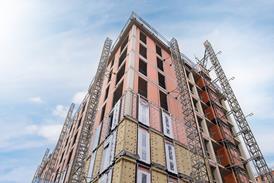In fact, the scheme, which Dunster terms "The Flower Tower", is designed to generate more energy than it uses, so that over time it pays back the embodied energy of the materials employed in its construction. This means that, eventually, the building has a slightly beneficial effect on the earth's climate. Or, as Dunster puts it: "It's a carbon-negative development." Despite its eccentricities, this is a radical attempt at a solution to the problem of increased housing density. The scheme has yet to gain a commission, but Pooran Desai of Dunster's environmental business adviser BioRegional Development Group says the design team "will be visiting China next month to discuss a scheme for Shanghai". The group is also talking to private developers looking to build a version of the tower as part of the Thames Gateway development.
The scheme's central tower is designed to be the hub of the community, containing all the facilities for its experiment in vertical living and most of the amenities for the surrounding low-rise development. The ground-level reception of this vertical utopia contains a farm shop "to re-establish urban links with the countryside" followed by four floors of retail and workshop space to provide the potential for a live–work community. Above that, there are 20 storeys of living accommodation topped by a floor of community facilities, including a restaurant, gym and nursery. An open-air, cloud-level sports hall is the building's final surprise.
The area around the 200 × 200 m tower is given over to a mixture of low-rise dwellings for families, a variety of work units, landscaped lakes and a football pitch. The density of the scheme could be as high as 500 people a hectare. "That's about the same density you get in inner-city developments like London's Soho," says Dunster.
The tower's accommodation is located in four petals set around a central concrete stem running the full height of the building. Within this concrete trunk are the vertical-axis wind turbines to generate electrical power. The building as a whole is permeable and the four "petals" are oriented to deflect wind into the tower's core – a design that should increase wind-speed by a factor of four.
Of course, there are obvious problems with designing a residential power station. Above all, the choice of turbine is critical if noise and vibration are to be avoided. Consulting engineer Whitby Bird & Partners, working on the concept with Dunster's practice, selected a helical-shaped machine that, although less efficient and more expensive than other types, is silent in operation and virtually vibration-free.
Petals made of timber
Unusually for such a high-rise development, the architect has chosen a timber-volumetric form of construction. The flats in each petal are designed to be factory-built as separate, highly insulated modules, each four storeys high, with a timber-stressed skin. These 11 m high units are then slotted into position around the concrete core and sandwiched between layers of concrete.
Both the accommodation and workspace modules can be manufactured on site using recycled timber and steel in a temporary workshop staffed by local labour. "We're challenging the assumption that skyscrapers have a high level of embodied energy," says Dunster.
Using modular accommodation pods will allow the tower to be constructed on a fast-track basis. After the construction of a concrete raft foundation and basement substructure, the concrete cores supporting the wind turbines and enclosing the escape stairs and lifts are constructed using a slip-form system, a method of casting the concrete using a continuously moving shuttering system. Once the cores are complete, the first four storeys of modules can be craned into place.
The concrete separating floor is then constructed using the modules to support the shuttering. This process of craning in modules and then casting a concrete slab is repeated until the tower reaches its full height. Mark Lovell, the project's structural engineer, calculates that the use of timber and low-embodied energy concrete would give the building an embodied energy rating of just 0.57 GJ/m2 over the floor area.
A conventional concrete-frame tower would embody 1.35 GJ/m2 of energy.
The concrete floors link the slip-form cores every four storeys and provide a rigid mounting point for the wind turbines. These links also form the sky gardens and allow the tower's occupants to cross from one side of the tower to the other.
Sunlight is important to the scheme. The building's southern elevation and the whole of the roof are clad almost entirely in photovoltaic panels. Although the building's photovoltaic skin will ensure that a large amount of energy is generated, it will also cast a large shadow to the north of the building. "If you place a value on sunlight you cannot take it away from people," says Dunster. For this reason, the area directly to the north of the tower is designated as a football pitch and has not been allocated for housing.
The combined electrical power of the wind turbines and photovoltaic panels generate enough electrical energy to meet the community's power requirements. Any shortfall in electricity is met by a combined heat and power plant set into a sunken pit in the tower's basement and enclosed in a glass case "to look like a micro brewery". Wood chips produced from urban tree waste will power the CHP system, with the waste heat from the unit used to provide hot water and space heating for the highly insulated wooden accommodation modules.
The tower basement houses the heavy and bulky hot water storage tanks and parking space for the community's car pool. It also contains Dunster's curiously named living machine – a sewage treatment system using a series of linked tanks to process the sewage using a condensed version of a reed bed system. This produces clean water that can be recycled for flushing toilet.
The processing tanks can even be used to grow plants, and Dunster plans to place these behind glass walls in the entrance lobby of the building. "The plants can even be sold at reception to provide a modest income for a gardening resident," says Dunster.
The "Flower Tower" has been presented to skyscraper guru Kohn Pedersen Fox as a solution to underdeveloped, overpopulated areas around the globe and Dunster is convinced that the scheme's environmental and financial benefits mean that it will gain funding. So with developments in Shanghai and London under consideration, it looks as if the "Flower Tower" may be given a chance to bloom.
Downloads
Cross section
Other, Size 0 kbThe Flower Tower
Other, Size 0 kb























